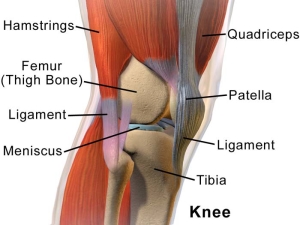Background – Knee Joint Pain Injections with Viscosupplementation
Hyaluronic acid (HA) is a naturally occuring substance found in the synovial (joint) fluid. This thick, gel-like fluid helps to lubricate and cushion the joint. People with osteoarthritis (OA) have less amount of HA in their joints. Viscosupplementation is a synthesized version of HA designed to be injected into the knee joint in people with OA. This is thought to help restore levels of HA, therefore improving the pain, mobility and function of the affected joint.
Who Benefits From HA injections
 The current HA injections on the market are only indicated for knee pain associated with OA, but continue to be studied for other joints as well. They are usually done in a series of 1-, 3- or 5-weekly injections. They are best suited for patients with mild to moderate OA that have failed other conservative treatment options. First-line therapies for OA include weight loss, physical therapy, nonsteroidal antiinflammatories (such as ibuprofen or naproxen), oral analgesic medications (acetaminophen), and cortisone (steroid) injections.
The current HA injections on the market are only indicated for knee pain associated with OA, but continue to be studied for other joints as well. They are usually done in a series of 1-, 3- or 5-weekly injections. They are best suited for patients with mild to moderate OA that have failed other conservative treatment options. First-line therapies for OA include weight loss, physical therapy, nonsteroidal antiinflammatories (such as ibuprofen or naproxen), oral analgesic medications (acetaminophen), and cortisone (steroid) injections.
The Injection Procedure for Knee Pain
Depending on which medication your doctor selects, you will be given an injection into the knee joint once weekly for the recommended time frame. After cleansing the skin, the doctor will often use a local anesthetic to numb the area. A needle is then inserted into the joint space. If there is a large amount of joint fluid (effusion), the fluid is removed or aspirated first. The HA is then injected into the joint. The procedure is done in the office setting, and sometimes under ultrasound guidance to confirm needle placement into the joint space.
Side Effects
Most common side effects are pain, warmth, or slight swelling at the injection site. This is usually self-limited and can be remedied by applying ice. Rarely a patient may have an allergic reaction to the medication and can manifest in more severe swelling or redness of the joint or the joint becoming more painful. These side effects should be reported to your doctor immediately. Any injection also has the risk of bleeding and infection, which remain rare.
Outcomes
You may notice benefit anytime after initiating the series of injections, but most people will not notice improvement until several weeks later. These injections have not proven to be beneficial for every patient, but have been reported to give lasting benefit of six months or greater. If helpful, the series of injections can be repeated every six months. Those with more advanced OA that do not respond to these injections often go on to have joint replacement operations. There is no cure for OA and these injections have not proven to reverse the joint degeneration associated with OA.
Alternatives
Other nonsurgical treatment options include orthobiologic (PRP or platelet-rich plasma, and bone marrow aspirate aka “stem cell”) injections. These more contemporary therapies have shown great promise for treating OA without surgery such as joint replacement (arthroplasty), but much more research is necessary and ongoing.
If you live or you are visiting the Lehigh Valley region, including Allentown, Bethlehem, and Easton areas and you are suffering from osteoarthritis (OA), consider making an appointment by calling (610) 954-9400 or schedule a doctor’s visit Online with Dr Scott Naftulin at NERA Spine, Sports & Pain Medicine.
We are committed to improving your life without a knife.
Reference:
- American Academy of Orthopaedic Surgeons. Viscosupplementation Treatment for Arthritis. Accessed 10/1/15.

